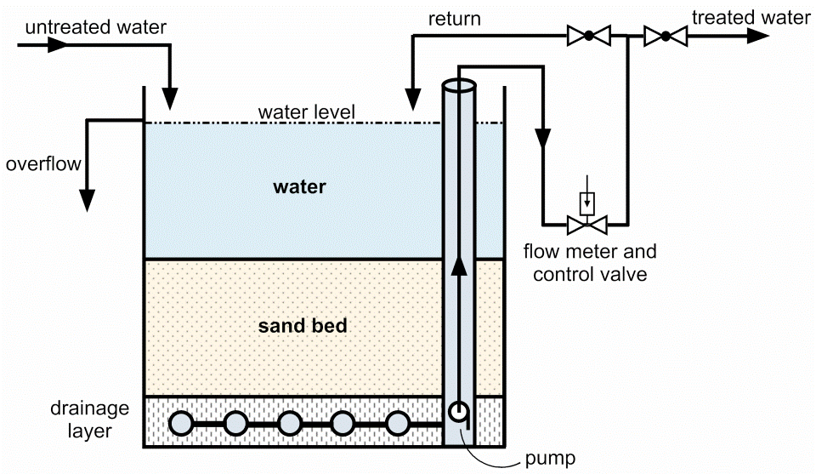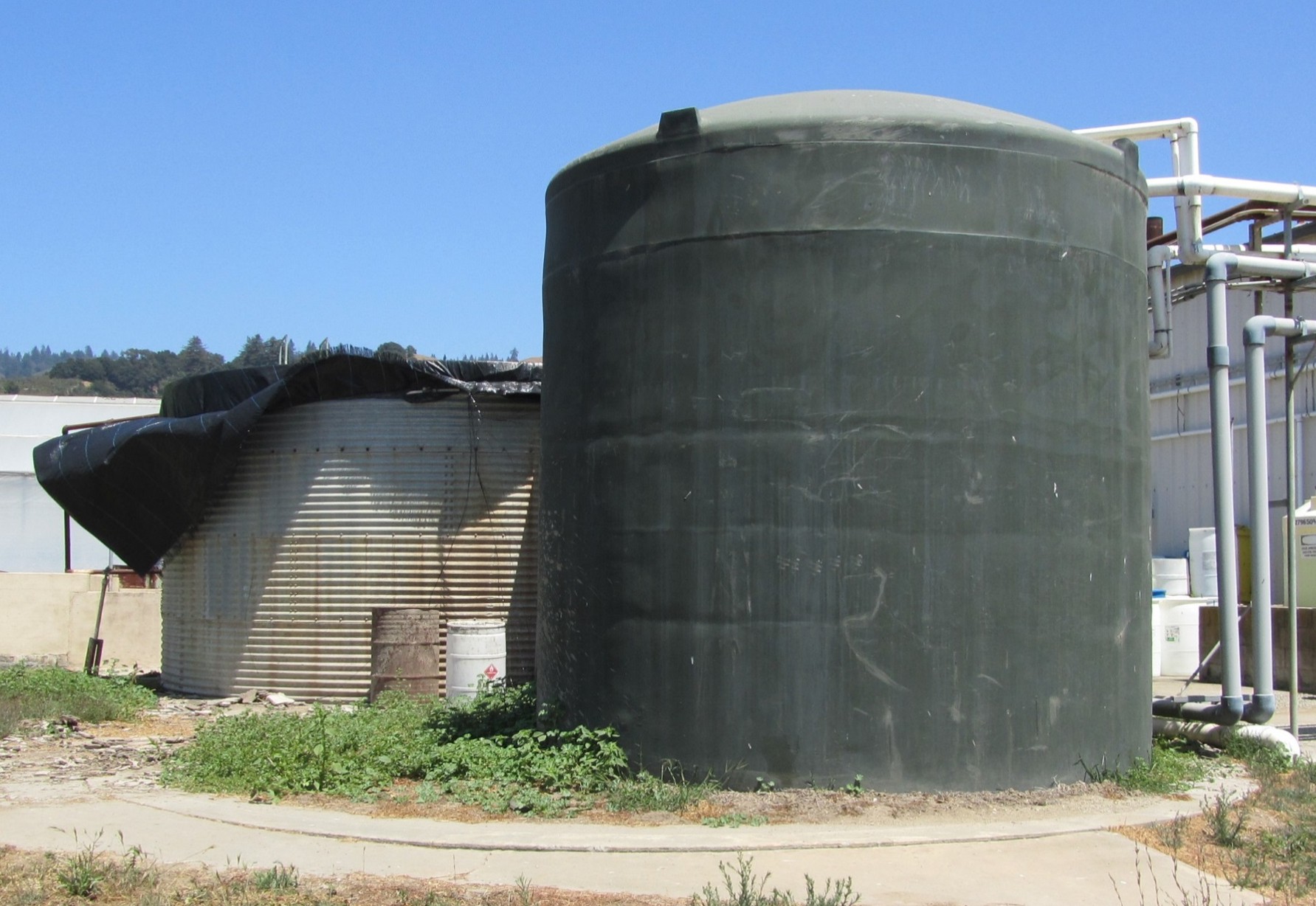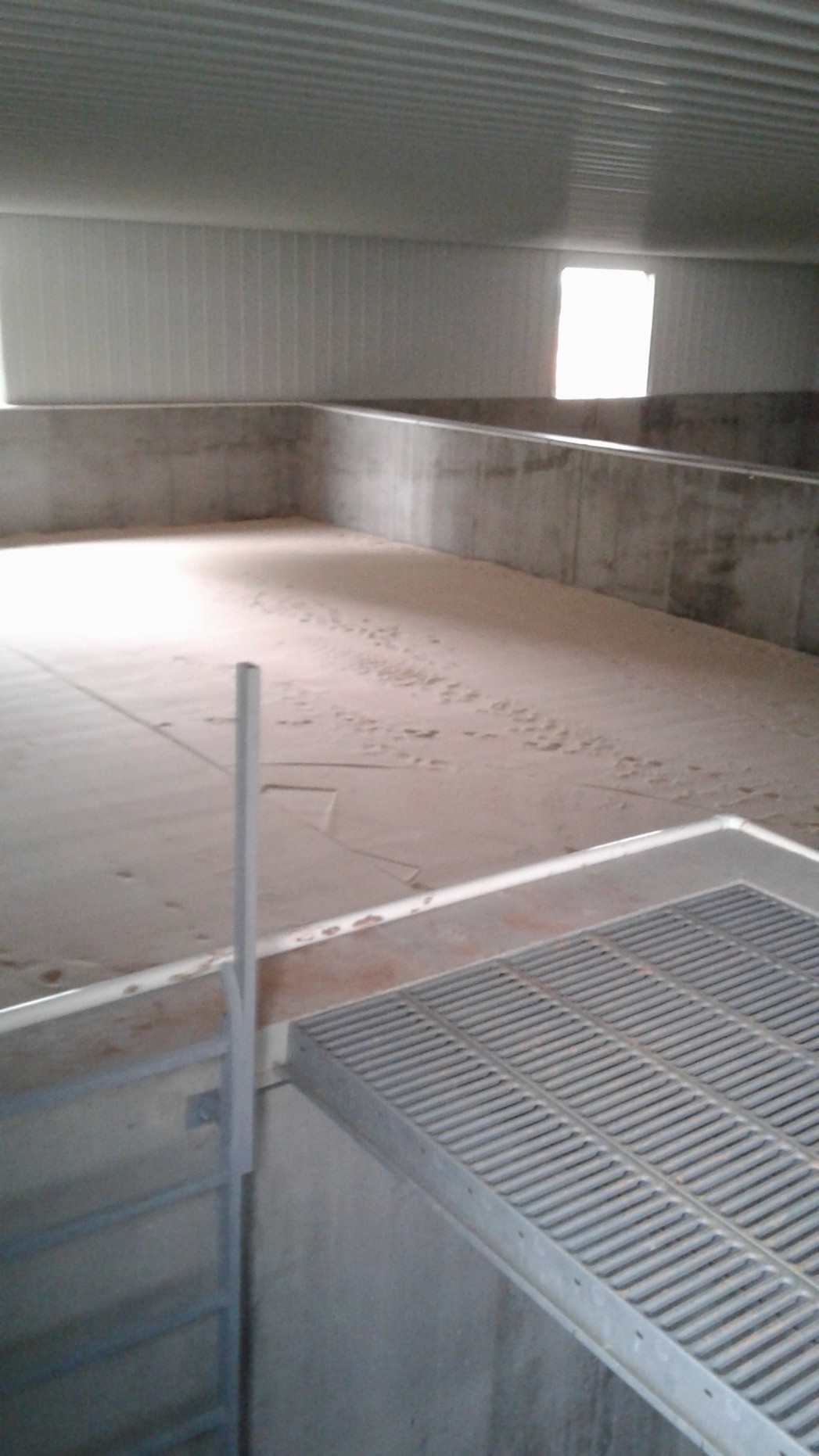Slow Sand Filtration:
A biological treatment technology to remove plant pathogens from irrigation water
Quick Summary
- Slow sand filters (SSFs) offer a sustainable, low-cost method to remove a wide range of plant pathogens, including fungi, bacteria, viruses, and nematodes, from recycled irrigation water in nurseries and greenhouses.
- SSFs rely on a microbial layer to biologically filter pathogens.
- Pros: SSFs are economical, requiring minimal maintenance and input. They do not significantly remove fertilizers, allowing nutrients to remain in the water for reuse.
- Cons: Due to slow flow rates, large filter areas may be needed for high volumes of runoff.
Introduction to Slow Sand Filtration
Recycled irrigation runoff water is a viable alternative for nursery and greenhouse production. However, it is likely to have plant pathogens present including: viruses, water molds, fungi, nematodes, and bacteria. To prevent plant pathogen spread, recycled irrigation water needs to be disinfected. Typical sanitation techniques include using chemicals (e.g. chlorine products or ozone), heat treatments, or ultraviolet light to kill pathogens. An alternative to these energy and chemical intensive methods is slow sand filtration (SSF), an old technology that has been used in European horticulture since the 1990’s and for drinking water since the 1800’s. SSFs were used to stop a cholera outbreak in the drinking water supply of Altona, Germany in 1892 because they are capable of removing human pathogenic bacteria and viruses.

SSFs can easily be confused with rapid sand filtration. Both of these technologies use sand as a substrate, although they are designed to achieve different goals. Rapid sand filters utilize very coarse sand grains (>1 mm) and operate at high flow rates (2-20 gpm per ft2 of sand bed) to remove particulates from irrigation water. In comparison, SSFs use medium sand grains (<0.6 mm) with very slow flow rates (0.06-0.2 gpm per ft2) to remove pathogens.
SSFs eliminate numerous plant pathogens and have been shown to remove water molds, viruses, fungi, bacteria, and nematodes. SSFs can remove pathogens via physical filtration processes but the sand mainly acts as a substrate for microbial growth. The microbial layer that forms on the sand particles is a diverse microbial community consisting of algae, actinomycetes, fungi, bacteria, protozoa, rotifers, flatworms, and nematodes that are the major mechanism of pathogen filtration. This microbe community is called “schmutzdecke” which translates to ‘dirty skin’ or ‘dirt layer’ in German. Most of the biofiltration performed by the schmutzdecke occurs within the top six inches of the sand bed and is predominantly an aerobic process. SSFs do not completely sterilize the water which leaves a diverse non-pathogenic microbial community that may provide other benefits.
Specifications:
- Sand quality
- Size: about 60-30 mesh (0.3-0.59 mm diameter)
- Uniform: uniformity coefficient (UC) <3
- Shape: rounded grains, not sharp sand
- 3 ft. of water over sand bed
- Sand must stay submerged
- Sand surface must not be disturbed
- Flow control is required
- Recommended sand bed depth of 3 ft.
- Recommend at least 2 filters: 1 to remain operational while the other is serviced.
SSF Components
SSF systems are very simple. The sand filter can be constructed in any container that can hold sand and water: e.g., drum, steel water tank, concrete septic tank, or earthen, lined reservoir. Sand filters are constructed with an under drain so that treated water can be collected once it has passed through the sand bed. (Figure 1).
Other components that are required include: a reservoir to hold captured runoff, a reservoir to store treated water, and a method (e.g. pump) to move the water between these components.
Management

Management of the SSF system requires frequent monitoring of water flow through the filter. If the flow rate is too fast, complete treatment may be compromised and the sand bed may quickly become plugged. The consequence of an exceedingly slow flow rate is that the desired volume of treated water is not generated.
When the desired flow rate cannot be achieved, then the sand bed needs maintenance. This requires draining the sand filter to expose the bed surface. The top layer of sand (about ½ - 1”) is removed and the sand bed is resubmerged. The water running through the scraped sand bed should be returned to the reservoir capturing untreated water for at least one day before returning the filter into service.
The interval for cleaning the sand surface can vary widely, but should be 2 months or longer if the filter is operating correctly. The cleaning interval is affected by schmutzdecke growth rate, temperature, pathogen load in water, flow rate, and most importantly, particulates in water. If there is too much suspended particulate matter (e.g. peat, coir, soil) in the recycled water, the SSF will clog very rapidly and require frequent cleaning. To avoid this, installation of a particulate filter, typically the finest mesh available or a settling tank or pond, before the SSF is crucial.
Nursery Applications
The advantage of SSF systems is the low requirement of additional inputs versus other treatment technologies. Chemical (e.g., chlorine, chlorine dioxide, or ozone), radiation (e.g., UV), or heat requires chemicals or energy to provide the treatment. Slow sand filters only require energy to move water, which is not different than any other treatment system, without the additional needs of chemicals or energy. Due to the lack of energy and chemical inputs, once installed, SSFs are fairly inexpensive to operate.
The tradeoff for these systems is space. A flow rate of 4-6 in/hr through the sand bed is recommended. One square foot of sand bed surface area operating at a flow rate of 6 in/hr translates to 3.7 gal/hr. This is about 90 gal per day per square foot of sand bed area. For example, we studied a ~50-acre nursery that grows container plants on gravel beds. The nursery generates 130,000 gallons of runoff per day; they would require a 42 ft diameter sand filter or about 1,440 ft2 of surface area.
An additional benefit of SSFs is that they do not remove significant amounts of fertilizers from the recycled irrigation water. This water can be reapplied as irrigation without reinjecting fertilizers which can save growers money on a plant nutrition program.

Pathogen Removal
SSFs have been shown to remove water molds (Phytophthora spp. and Pythium spp.), viruses (Tobacco Mosaic Virus), fungi (Fusarium spp.), and bacteria (Xanthomonas campestris) from irrigation runoff water. There is potential to remove nematodes (Radopholus similis) as well. The time it takes the schmutzdecke to develop for pathogen removal can vary depending on pathogen type and may be temperature dependent. In research trials, it has taken two weeks for Phytophthora and Pythium removal and up to nine weeks for removal of TMV. Cooler temperatures can affect schmutzdecke development by reducing microbial community growth. However, once schmutzdecke has developed to remove a particular pathogen, it will filter that pathogen for the longevity of the filter, excluding the twenty-four hour periods after filter maintenance.
As an added benefit, SSFs may be able to remove some pathogens without previous exposure. An SSF exposed to Fusarium oxysporum eliminated Phytophthora capsici from the filtered water without previous exposure to P. capsici. In the same trial, a pump failure was simulated by turning off the water supply to the top of the SSF. After seven days, flow was resumed and Phytophthora was removed immediately. It is important to point out that the water above the sand bed was maintained to keep the schmutzdecke from drying out. Desiccation of the schmutzdecke may result in an ineffective SSF for a prolonged amount of time.
SSFs are good low-cost and low-tech systems for purifying recycled irrigation runoff water at nurseries and greenhouses. They have the ability to remove a variety of plant pathogens via biological filtration and require minimal maintenance. As flow rates are slow, SSFs may need to be fairly large for treating the significant volumes of runoff water generated by container production operations but if a grower has space, they can be much cheaper than alternative methods. Additionally, two filters are recommended to reduce down time while filter maintenance is performed.
References
- Merhaut, D. J. (2008). Water recycling in nurseries. Greenhouse and nursery management practices to protect water quality. J. P. Newman. Oakland, CA, University of California Agriculture and Natural Resources Communication Services: 98-100.
- Newman, J. P., J. N. Kabashima, D. Merhaut, D. L. Haver, J. Gan and L. R. Oki (2014). Controlling runoff and recycling water, nutrients, and waste. Container nursery production and business manual. J. P. Newman. Richmond, CA, University of California Agriculture and Natural Resources Communication Services: 108-110.
- Oki, L. R., L. L. Nackley and B. Pitton (2016). Slow sand filters: a biological treatment method to remove plant pathogens from nursery runoff©, International Society for Horticultural Science (ISHS), Leuven, Belgium.
- Oki, L. R., L. L. Nackley, B. J. L. Pitton, S. Bodaghi, E. Lee, D. L. Haver and D. M. Mathews (2016). "Slow sand filters remove Tobacco Mosaic Virus." UCNFA News 20(2).
Bruno J.L. Pitton is an Environmental Horticulture Advisor in Placer and Nevada Counties; Grant Johnson is an Urban Agriculture Technology Advisor in Orange and Los Angeles Counties.
